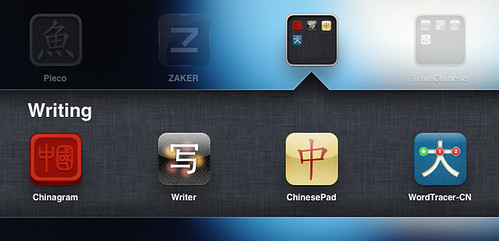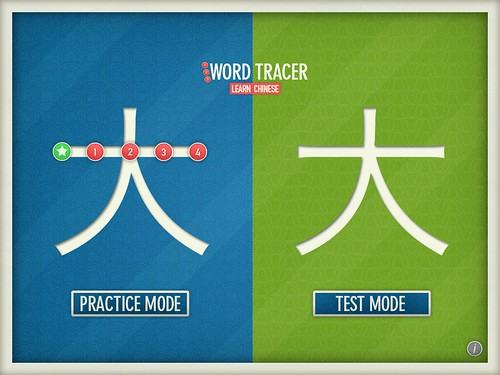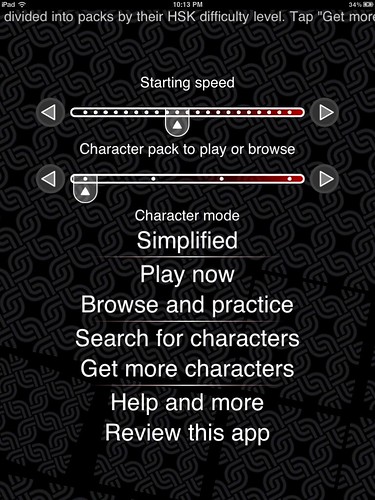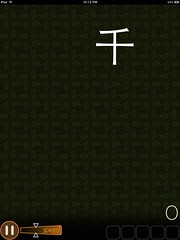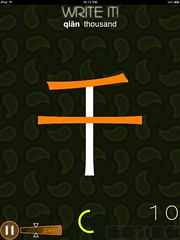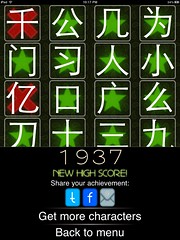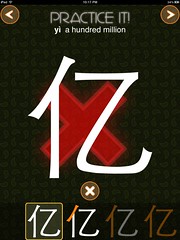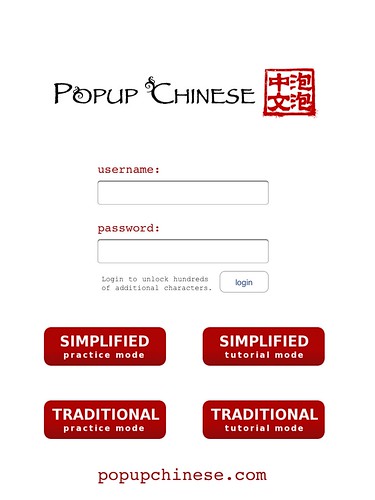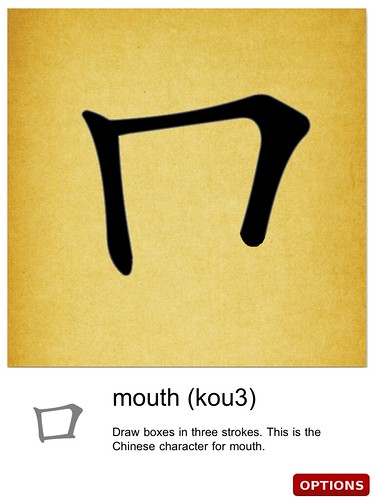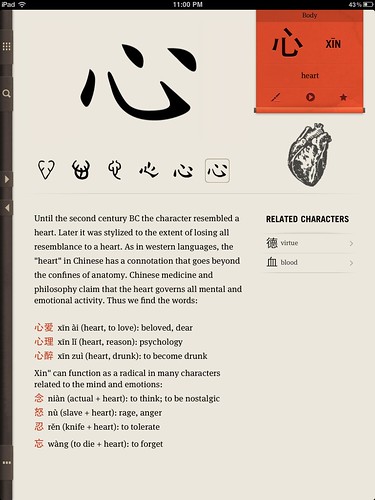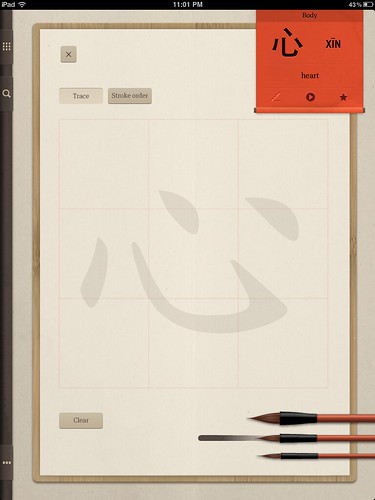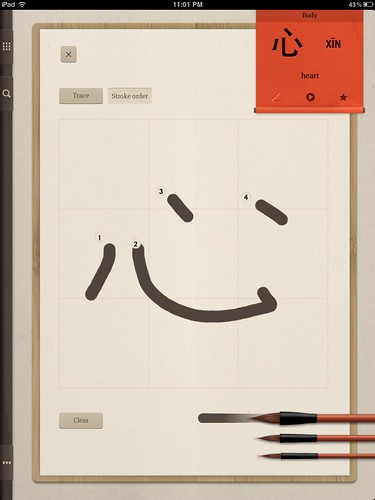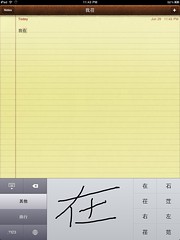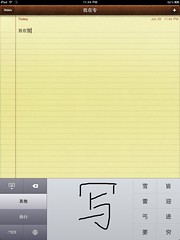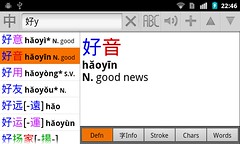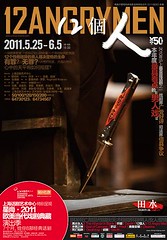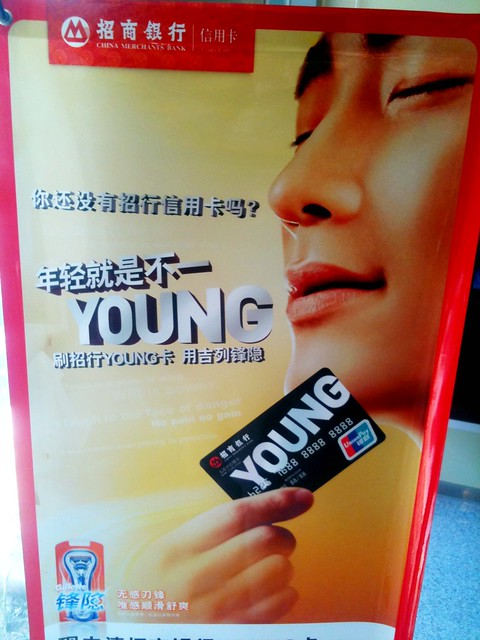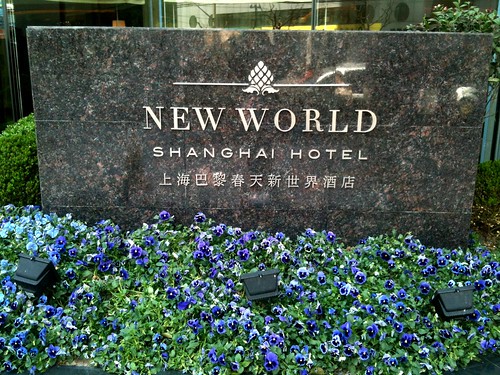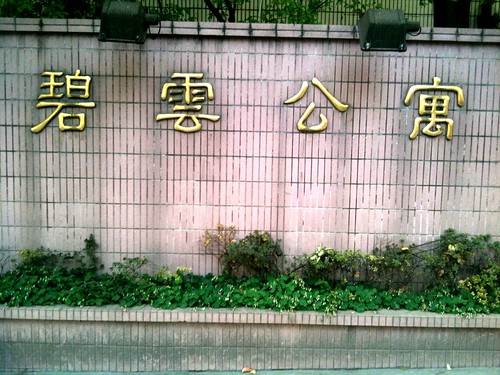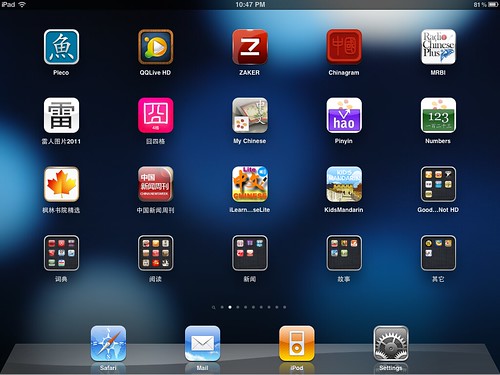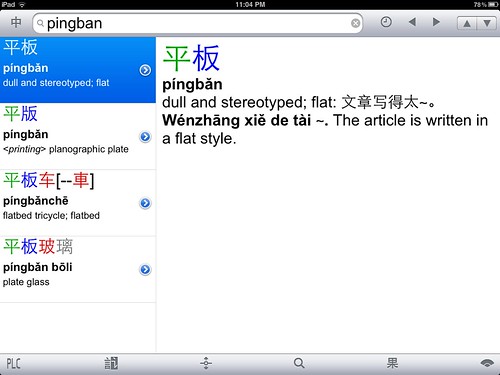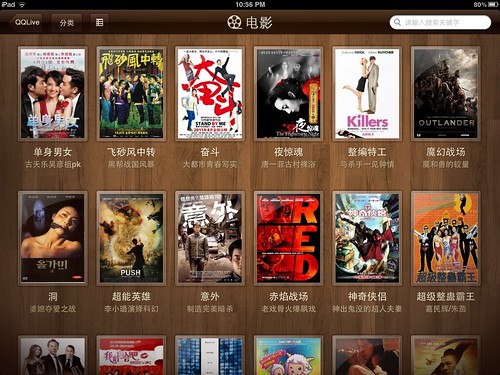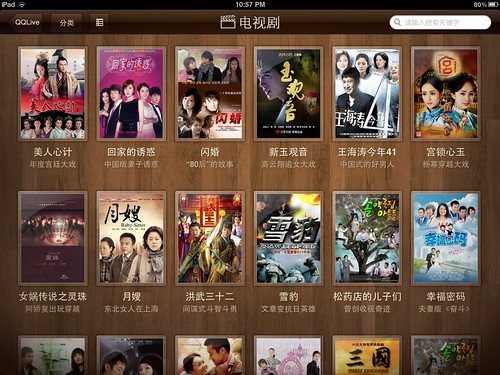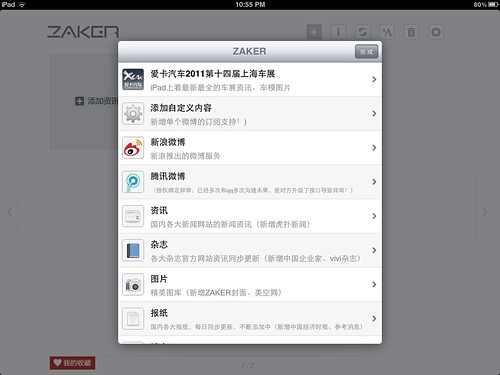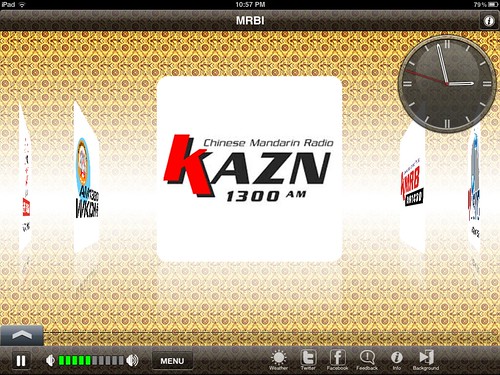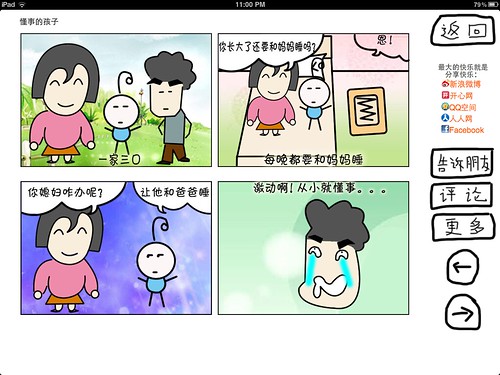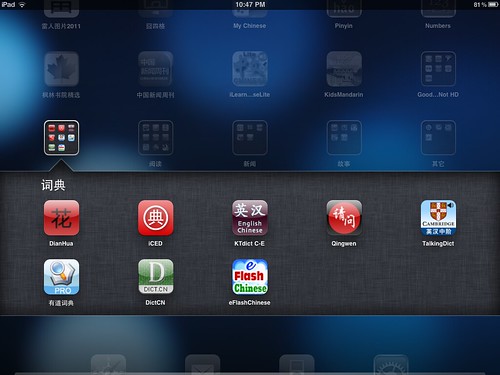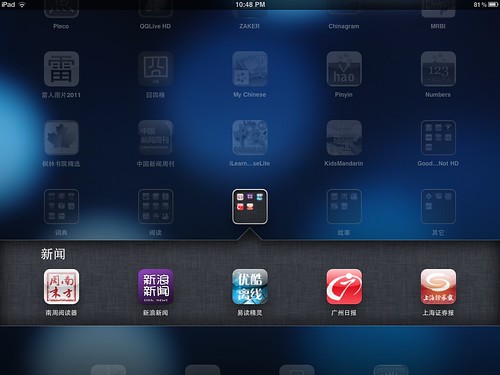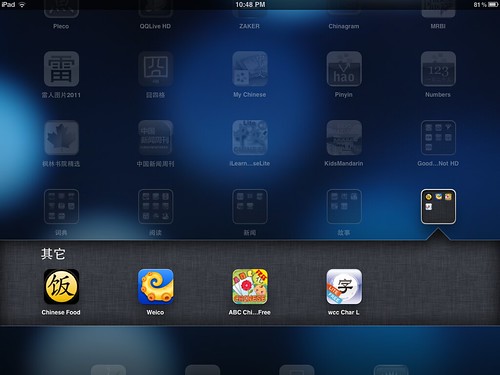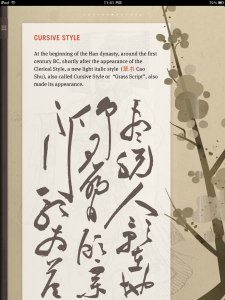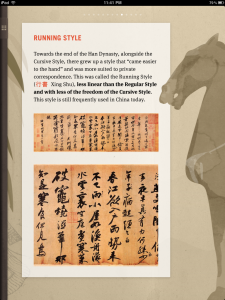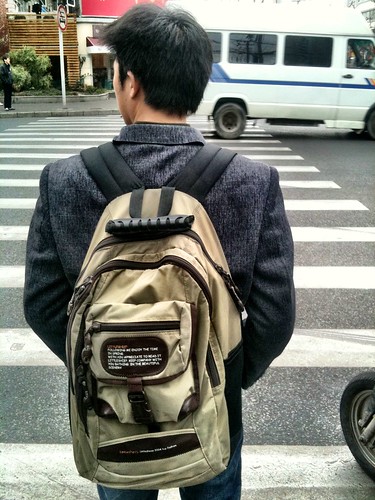30
Jun 2011Learning to Write Chinese Characters on the iPad
One of the reasons I rushed to get an iPad for my own company is that the iPad is the leading tablet computer device, and tablet computers, with their relatively large touch-driven screens, seem uniquely poised to offer a great learning experience for a new generation of learners. Now that the iPad has been out for a year, developers have had some time to dig into iOS and create some cool apps for learning to write Chinese characters.
The only problem is that they haven’t yet. It’s not that they haven’t done anything, it’s just that no major player with a lot of resources has put a lot of effort into creating a superior app just for teaching writing. Significant effort has gone into Pleco‘s iOS handwriting recognition and OCR function, but neither of these teaches writing.
Before I go into my reviews of the handful of Chinese writing apps I found, I should first pose a question: what should an app that teaches Chinese characters do? This is a question that at times seems neglected by app creators. It’s easier to focus on what can be done with an app, rather than what needs to be done for real learning.
To effectively teach the writing of Chinese characters in a comprehensive way, an app would need to do the following:
1. Introduce the basic strokes, emphasizing the direction in which each is written and the shape of each.
2. Introduce the building blocks of Chinese characters, calling attention to how they function is a part of a whole.
3. Introduce the various structural types exhibited by Chinese characters, and the order in which characters’ various component parts should be written.
4. Introduce new characters in a progressive way, building on what has come before, while still trying to stick to useful characters as much as possible.
5. Provide practice writing the characters and give feedback.
This issue goes way beyond the scope of this blog post, but the point is that most of the apps out there now stick mainly to #5. Because most of the apps are largely about practicing writing, I’m going to talk mostly about the concepts of tracing and feedback. Now onto the reviews…
Word Tracer
Price: $4.99
| Feature | Description |
| Tracing | Yes (it’s in the name!) |
| Feedback | Yes, a green star tells you where to start writing when you go off track. You’re not allowed to write incorrect strokes. |
| Free-form writing | No; tracing only |
Word Tracer is a very polished app. It’s attractive and was clearly crafted with care. The issue of stroke direction takes center stage in this app, as a star in a green circle tells you where to start, and a series of numbers in little circles show you which way to make the strokes.
While the app is not a course in characters (which would need to go through numbers 1-4 I outlined above), it does offer a nice collection of characters to choose from, ranging from a frequency list to common phrases. I missed this feature at first, and it definitely adds a lot.
Overall, the app shows a lot of attention to detail. It wasn’t created to be a writing course, so it’s mainly a polished “writing practice app,” and its name very clearly states what this app is all about: tracing. It can’t help you with recalling characters without any prompt and writing them out.
On the plus side, I actually met with the main developer in Shanghai, and he seems quite open to suggestions for improvement, and has plans to make the app better. (Full disclosure: the developer let me try out this app for free.)
If you’ve already learned how to write characters and are looking for a mechanical way to practice writing on your iPad, this app is not a bad choice.
trainchinese Chinese Writer
Price: Free (for the basic app)
| Feature | Description |
| Tracing | Yes, in game form |
| Feedback | Yes, a big red “X” tells you when you make a mistake but gives you no immediate clue where you went wrong. You’re not allowed to write incorrect strokes. |
| Free-form writing | No; tracing only |
I really like that this app tries to be a game. It’s not the most fun game in the world, but I’ve seen more than one learner really get into it. The timed aspect also adds another dimension which makes the “trace the strokes” mechanic a bit less monotonous (at least for a while). I also like the options in the beginning (although that screen with its crazy animated background is a little busy).
The way the game works is that characters slowly drop for the top of the screen. You tap them once to zoom in, then quickly trace over them to “destroy” them. That’s it. If you can write a character especially fast, you are praised with a “很快” (“very fast”). If you’re too slow or keep getting the strokes wrong, the character eventually drops off the bottom of the screen, and that’s one strike against you.
One of the best things about the app is that at the end, after you’ve gotten your 5 wrong characters and the game is over, the game shows you which characters you got right and which you got wrong, and then you can review the correct stroke order for the ones you got wrong. The app is never especially clear about the direction of strokes, however.
In the end, it’s tracing only, and the characters are chosen at random. The app is solid, though, and it’s free. Not bad for basic mechanical writing practice.
Chinese Writer for iPad
Price: Free (tutorial only; additional account required for other functionality)
| Feature | Description |
| Tracing | No |
| Feedback | Yes, the correct stroke flashes on the screen when you make a mistake. You’re not allowed to write incorrect strokes. |
| Free-form writing | No |
Chinese Writer sets itself apart in that it is not a tracing app. It’s slightly confusing at first, because (1) the app button is labeled “ChinesePad,” and (2) it seems like you have to sign up for a Popup Chinese account to use the app, since neither the simplified or traditional “practice mode” seem to do anything. Apparently only the “tutorial mode” is available if you don’t have a subscription (that button works).
As you write each stroke, the app shows your stroke in red, but it doesn’t actually save it on the screen; it either accepts it as “correct” and replaces it with a print-style version of the stroke, or it rejects it and erases it, flashing the correct stroke in the correct place to prompt you.
In theory, the app is fine, sort of a simpler version of the Skritter system. It can be confusing, though, rejecting seemingly perfect strokes, and rejecting quite imperfect ones.
The app is free, and will be updated in time, according to Dave Lancashire, the developer. When asked if it will stay free, his reply was, “I can’t see changing the price, although you should tell people it will be $99.99 next week so GET IT NOW!”
Chinesegram
Price: $4.99
| Feature | Description |
| Tracing | Yes (optional) |
| Feedback | No automated feedback, just a layer of numbers to indicate where strokes should start |
| Free-form writing | Yes |
Chinagram is not free and contains a very limited number of characters, but in many ways, it’s my favorite of these apps. While it doesn’t teach strokes or radicals, it does show the evolution of the characters through various scripts over time, and offers graphics to help clarify the pictographic characters.
I also like how the app offers very free-form writing practice. There’s no computer program to tell you you’re right or wrong. There’s simply a faint guide which can be switched on or off, and some little guide numbers to help with stroke order, which are not tied to the tracing guide, and can also be independently turned on or off. This simple combination of options makes for a quite satisfying range of writing practice possibilities.
With Chinagram, it does kind of feel like you’re paying for design and pretty graphics, but let’s face it: characters are graphic. Chinagram offers an attractive and appealing, although somewhat limited, introduction to the writing of Chinese characters. I’d still want more instruction on how to write characters than this app offers, but it definitely goes farther than the three above.
(See also my original review of Chinagram.)
Chinese Handwriting Input + Notes
Price: Free (comes with the iPad)
| Feature | Description |
| Tracing | No |
| Feedback | Indirectly, because if you’re too far off in your stroke order, the character you’re trying to write won’t appear |
| Free-form writing | Yes |
One of the things that struck me while reviewing these iPad apps is that (1) many of them assume some previous study of characters, and (2) if you’ve previously studied characters, there’s probably nothing better than just writing. And the iPad let’s you do that out of the box. All you need to do is enable Chinese handwriting input:
Once you’ve got that working, go into the “Notes” app (or anything that lets you write text, really), and just try to write something. You’ll learn a lot just by the act of writing the characters stroke by stroke, and identifying the one you want from the resulting list of characters. If you get a character totally wrong, chances are, it won’t be in the list. Try again.
(In the example above on the right, the correct character “写” meaning “to write” is written in a way that is clearly recognizable, but does not appear in the list of resulting characters because the stroke order/direction used was totally wrong.)
This really is not a bad option for practicing writing, especially if you have someone you can write to.
My conclusion: these apps are worth checking out, but better writing apps for Chinese are still needed!
I have a student intern at AllSet named Lucas, who kindly gave me his own feedback on the four apps above. Lucas has studied Chinese for three years in college, and is currently studying Chinese in Shanghai for the summer. I asked him to rank the four apps, and make some comments about each. Here are his independent picks, #1 being his favorite:
1. Chinesegram: “Seeing the picture and comparing the scripts and evolution helps me remember them better.”
2. Word Tracer: “Helpful for learning stroke order, but a bit over-sensitive, which can be frustrating.”
3. trainchinese Chinese Writer: “Kinda funny, I guess, but I don’t like the time pressure.”
4. Chinese Writer for iPad: “It’s too sensitive; it kept making me redraw the strokes.”
Related: iPad Apps for Chinese Study (2011)
27
Jun 2011The Naked Wedding
The Chinese neologism 裸婚 (literally, “naked wedding”) came up in an AllSet Learning client’s lesson, and I think it’s an interesting word with social implications, worth taking a look at.
The word has its own page on the Chinese wiki Hudong: 裸婚. The brief explanation is:
> “裸婚”指的是不买房、不买车、不办婚礼、不买婚戒,直接登记结婚的一种节俭的结婚方式。自古以来,婚姻一直都被人们看做是人生的头等大事,而婚礼的隆重与否直接体现了整个家族的地位。然而,近年来“裸婚”风渐渐盛行,成为“80后”最新潮的结婚方式。
And the English translation:
> “Naked wedding” refers to not buying a house, not buying a car, not having a wedding ceremony, not buying wedding rings, and just directly registering legally for marriage as a way to save money. Since ancient times, marriage has always been seen as a major event in a person’s life, the pomp of the ceremony directly reflecting a family’s social status. The gradual popularization of the “naked wedding,” however, has emerged as a new wedding trend for the post-80’s generation.
Industrialization and commercialization in a society are inevitably followed by a generation that rejects the new materialistic forms of social status, right? Here’s another sign that the forces for such a social change are building in China…
17
Jun 2011Writing Apps Wanted
I’m getting ready to do a review of iPad apps that teach writing Chinese characters. I’ve got a few to review already, but I’m very open to additional suggestions. It’s hard to find everything in the App Store.
If you’re a developer with a paid app that teaches Chinese writing, your chances of getting reviewed are much higher if you email me a promo code. 🙂
Have a good weekend!
June 24th UPDATE: Thank you for the replies I’ve gotten by comments and by email. This week has been busy, but the post will come out next week.
14
Jun 2011On Reducing TMD Syntactic Ambiguity
One of our teachers at AllSet Learning introduced a hilarious Chinese article to me on the grammatical usage of the phrase 他妈的 (often abbreviated as “TMD”). The most appropriate translation of 他妈的 in English is usually “fucking” (in the emphatic sense), so if that offends you, stop reading now.
The origin of this article is unclear to me, but it dates back to at least 2009 (here’s a copy). Anyway, I found the article both funny and instructional, so I’ve translated it below. This is the kind of thing that has tons of translation options, though, so suggestions for more skillful translations are always welcome!
The grammatically correct use of “TMD” (“fucking”)
In this article, I will offer some simple explanations and examples regarding this expression.
-
Consider the following sentence:
今年的考题跟课后题一样。
This year’s test questions were the same as the exercise questions.
There’s ambiguity here: are we saying that that the questions on the test were really the same as the exercise questions, or are we just metaphorically stating that the test questions simply resembled the exercise questions? At this time, “fucking” becomes useful. We can insert “fucking” into this sentence to make the distinction:
今年的考题跟课后题他妈的一样。
“This year’s test questions were the fucking same as the exercise questions.” (indicating identical to the exercise questions)
今年的考题跟他妈的课后题一样。
“This year’s test questions were the same as the fucking exercise questions.” (suggesting that the test questions were too simple)
-
There are many similar cases, for example:
[Translator’s note: I don’t think there’s any way to preserve this ambiguity in English translation, so I’m forced to translate it twice in English.]这个解释不清楚
“This explanation is unclear.” / “This cannot be explained clearly.”
There are two meanings here: that the explanation itself is not lucid, or that the matter is difficult to explain. However, once we add “fucking,” the ambiguity immediately disappears:
这个解释他妈的不清楚
“This explanation is fucking unclear.” (the explanation itself is not helpful)
这个他妈的解释不清楚
“This cannot be fucking explained clearly.” (the issue is difficult to explain)
-
Another example:
没有一次看完
“Didn’t finish reading it once.” / “Didn’t finish reading it all at once.”
This sentence has two meanings: did not finish reading it a single time, or didn’t finish reading it all at once. If we insert “fucking” in different positions, the ambiguity can also be removed:
没有他妈的一次看完
“Didn’t fucking finish reading it all at once” (didn’t finish reading it all in one go)
没有一次他妈的看完
“Didn’t finish reading it fucking once”
(simply has not ever finished reading it)
Therefore, our fucking conclusion is that we should advocate the fucking inclusion of “fucking,” which can fucking assist in the clarity of fucking sentence structure, reduce fucking syntactic ambiguity, and make possible obstacle-free fucking communication.
10
Jun 2011Basic Patterns of Chinese Grammar
Edited by Qin Xue Herzberg & Larry Herzberg (Stone Bridge Press, 2011)
Review by: John Pasden
I quite enjoyed this book on Chinese grammar, but the student would do well to be clear on exactly what this book is and what it is not. Right on the cover are two huge clues:
> A quick study handbook with over 75 key constructions for reference and practice
> A Student’s Guide to Correct Structures and Common Errors
In case it’s not obvious, this book is not the place to start learning Chinese grammar. Sure, it’s packed full of great information and important side notes, but it’s going to be most valuable as a reference material, such as a handbook for a student who’s studied Mandarin for a year, then plans to go to China, but doesn’t want to take his old textbooks.
07
Jun 2011China Lite
As someone who’s taken up residence in China long-term, I’ve had quite a few visitors over the years. One of the things I’ve learned is that you have to do a little “visitor profiling” if you want your guest to have a good time. Two of my own personal “case studies”:
1. My sister Grace visited me in Hangzhou in 2001. I hadn’t been in China long, and had spent a lot more time studying Chinese than trying to get comfortable. I fed Grace the 5 RMB local cafeteria food I was used to eating. When we went from Hangzhou to Beijing, I screwed up on the sleeper “ticket upgrade,” so it was 17 hours on the train in hard seats. In Beijing, we went everywhere on foot, by subway, or by bus. Poor Grace didn’t adapt too well to Chinese food; I think she might have had western food a few times, but she also shed quite a few pounds during her two weeks in China.
2. My parents visited China in 2007. We toured West Lake in Hangzhou, and went on a Bund cruise in Shanghai. We flew to Beijing and saw the sights there, assisted by a driver. We took the cable car up to the top of the Great Wall. We sampled the local food everywhere, while also getting some western food when it felt “necessary.” My parents had a very pleasant stay (but probably didn’t lose any weight).
Fortunately, by the time my parents had visited, I was a bit more compassionate about the needs of my less hardcore visitors (and had had a chance to practice this “kinder, gentler version of China” when my other sister Amy visited in 2004). Grace actually had a really good attitude about the whole ordeal, though. She felt that she had had a taste of “the real China,” and referred to what my sister Amy had experienced as “China Lite.”
I’m not trying to be a China snob here; this “China Lite” concept is useful. With my parents planning another visit, I’m working on perfecting the China Lite experience (without resorting to a tour group, if possible). While the whole “Real China” vs. “China Lite” thing is more of a continuum than a black or white issue, I’ve found it useful to compare the two.
| Real China | China Lite |
| Stay in hostels, crash at friends’ places, or even do some kind of homestay | Stay in nice hotels or service apartments |
| All Chinese food, and the more street food the better | Chinese food is fine as long as it’s not too weird; some western food (even KFC) is needed to buffer all that Chinese food |
| Baijiu (that Chinese white grain alcohol) isn’t so bad… | Tsingtao is exotic enough when it comes to alcohol |
| As much Chinese language as possible; gotta put that phrasebook to use and communicate with the locals | English if possible; translations if not |
| Travel by bus, train, and bike (with the people) is great | Airplane preferred for long trips; other forms of transportation need to provide appropriate personal space |
| Pack your own TP, and study the proper squatting position in advance | Never stray too far from a western-style toilet |
| China is big, and you don’t have much time to soak it all in, so pack that itinerary tight! | China is tiring; plan the itinerary carefully and leave sufficient down time |
| Consider the whole trip to be “off the grid” or at least “off the beaten path” with just the occasional internet cafe | Plan for internet needs, and provide a cell phone for your visitors if possible (the cost of the SIM card and phone service is negligible in China) |
Got any tips to add the the list?
Some visitors are looking for “the real China,” where others are hoping to enjoy “China Lite.” They’re both here, but it’s best to be clear on what your visitors are after.
Other takes on “China Lite”:
– China Lite in the New York Times
– China Lite on globorati
– CNYE in China Lite by Ryan McLaughlin
02
Jun 2011Pleco for Android + More Dictionaries!
Pleco has announced its long-awaited Android version (screenshots here)! This is interesting to me, because one of the major reasons I switched from an Android phone back to an iPhone was Pleco. I haven’t seen the Android version in action, but looking at the screenshots, it would seem that the iPhone is getting more Love.
From the Pleco Android beta announcement:
> This is an experimental release of our Android software; we’re making it available now for the sake of people who don’t want to wait any longer for the finished version, but there are quite a few bugs / ugly interfaces, the documentation is almost nonexistent (though you can get a pretty good idea of how it works from the iPhone version documentation), and there are also a few major features missing, so if you’re not very computer-savvy we’d recommend waiting for the finished version to be ready before downloading it, or at least waiting a few weeks to see what the feedback from other testers looks like in our discussion forums.
> In general, though, we’re very pleased with how our Android software turned out and with how much functionality we have been able to get into this first release. OCR (see below) is working beautifully on Android (both live and still, though currently only in “Lookup Words” mode), as are full-screen handwriting recognition, audio pronunciation, stroke order, and all of our add-on dictionaries. We’ve even gotten a significant portion of our document reader module working; there are no bookmarks or web browser yet, and it’ll choke if you try to load the complete text of 红楼梦, but for short-story-sized text files and snippets of text copied in from the clipboard it works quite well.
Meanwhile, the iPhone and iPad versions forge boldly ahead as well. I’m looking forward to the upcoming UI redesign. This part of the announcement was interesting:
> Central to this is a new feature we’re calling “merged multi-dictionary search”; basically, instead of typing in a word and having to flip between different dictionaries to see which matches they come up with, you’ll get all of the results from every dictionary in a single, sorted, duplicates-merged list, providing better information and doing it in a simpler way. That particular feature is actually likely to show up in an experimental form (off-by-default option) in a minor update we’ll be putting out in a few weeks; we want to make sure it’s working really well before we put it at the center of our product.
When I heard that Michael Love was looking for more dictionaries to license for Pleco, my initial reaction was, “why do you need more dictionaries? Add more dictionaries and it’s just too much hassle to navigate through them all.” And that’s a problem that this new “merged multi-dictionary search” would solve. I’m very interested to see what that ends up looking like, and how it affects the user experience.
So what are the new dictionaries being added to Pleco?
1. “the Oxford Concise English & Chinese Dictionary (now known as the Pocket Oxford Chinese Dictionary)”
2. “the Classical-Chinese-to-Modern-Chinese dictionary”
3. “the Traditional Chinese Medicine dictionary”
4. “the expanded edition of the Tuttle Chinese-English dictionary, and its companion English-Chinese title”
5. “a really nice multifunction Chengyu dictionary (detailed explanations, usage notes, antonyms/synonyms, etc)”
6. “a lovely little Chinese-Chinese student dictionary”
7. “another Chinese-Chinese student dictionary that would be our first title ever to be oriented around non-mainland users (i.e., the original print version is in traditional characters)”
Wow. And Pleco is still searching for a decent Cantonese dictionary and a character etymology dictionary to license.
31
May 201112 Angry (Chinese) Men
As a result of a rather whimsical decision made by my wife, I found myself at the Shanghai Dramatic Arts Centre for the first time last Saturday, attending a Chinese language version of the classic play Twelve Angry Men. I enjoyed it way more than I expected to.
To begin with, I was surprised by how “Chinese” the story seemed. The part about there being no air conditioning and the fan not working, and one of the guys wanting to be done with jury duty in time for a ball game (it was baseball originally, I believe), and the murder weapon being a knife rather than a gun–all just seemed to work well in the setting of Chinese society. It wasn’t until towards the end, when one of the characters started talking about how the jury’s deliberation was their duty as part of a “democratic society” and that “democracy made their country great” that the illusion sort of fell apart.
This isn’t to say that I think that modern day China is equivalent to the 1954 America in which the original story was set, but it’s interesting to me that it worked so well in this case.
I should also mention that the legal system of mainland China doesn’t make use of juries, so the “illusion” that it could be a mainland Chinese story was never very convincing to begin with. It did make for a good show, though.
I brushed up a little on my legal vocab before the play (ChinesePod has a fair amount), but it turned out that I didn’t need a whole lot. Some of the more difficult key vocabulary from the play:
– 贫民窟: slum
– 陪审团: jury
– 陪审员: juror
– 证词: testimony
– 合理的怀疑: reasonable doubt
Finally, a note on the title. This version of the play was simply titled 12个人 (12 People), but the previous movie version was called 十二怒汉 (12 Enraged Men). The classic version of that film is on Tudou under that title.
26
May 2011Puns on the Streets of Shanghai
Recently I just happened to catch this wordplay on the streets of Shanghai around me:
年轻就是不一YOUNG / 不一样. (After reading this pun, go here.)
最高G密 / 最高机密 (“top secret”); G = 鸡 = chicken. 鸡米 is a name for little chicken nuggets (often fried).
新视界 / 新世界
Not a pun; just illustrating that 新世界 is a common phrase too. This hotel is just around the corner from the eye hospital above.
碧云公寓 (traditional characters are used in the photo): not a pun either; this just amused me because we foreigners have a habit of mixing up our tones. This apartment complex could easily become “Contraception Apartment” (避孕公寓) pronounced by a careless foreigner.
24
May 2011Do I need a VPN for China?
I’ve gotten quite a few questions about VPNs lately. I also opined in a recent comment that, “There was a time when you could reasonably get by without a VPN in China. That time is over.”
For this post I’d like to return to the basic question which so many of my readers seem to have: do I need a VPN for China? Since each person’s situation is different, rather than just flat-out answering that question, I made up a little quiz to help you figure it out yourself.
Do I need a VPN for China? (a simple quiz)
1. Do you need to use Facebook at all? (This includes services like Quora that require Facebook connect, and also every little “Like” button on the internet.)
2. Do you need to be able to see YouTube (or Vimeo) videos? (Remember, it’s not just going to the YouTube site. YouTube videos are embedded in sites all over the internet.)
3. Do you need reliable access to non-YouTube Google services such as Gmail, Google Docs, Google Calendar, or even Google image search?
4. Do you need to use Twitter? (Remember, whether it’s through the site or a third party app, you’re still going to need a VPN or proxy of some kind to access Twitter.)
5. Did you find yourself uncomfortable with at least two uses of the word “need” above, telling yourself, “well, I don’t really need it…”?
Scoring
How many times did you answer “yes” to the questions in the above quiz? If the total is 1 or higher, you will likely be much happier in China if you just shelled out the cash for a decent VPN.
Note: I don’t usually publicly share which VPN I use, but if you send me a nice email, I will probably tell you.
18
May 2011Xiaoli is very weird
I just discovered these bizarre videos on Youtube called iamxiaoli. They’re supposed to be for learning Chinese, but they’re a little unorthodox, to say the least. Here are two of the ones I found more interesting:
0003 How To Say “Friend” In Chinese
0005 How To Say “What is This?” & “He Doesn’t Know” In Chinese
I’m curious how effective these videos are at teaching Chinese. Can anyone voice for having learned some words or phrases from these videos?
Anyway, Xiaoli got my attention. The (sparse) website is at iamxiaoli.com.
Not in content, obviously, but in some ways this stuff reminds me of ChinesePod in its early days, trying something new and different, unafraid to explore and experiment. I’m not surprised that this particular effort came out of Beijing.
Via Study More Chinese, via Social Mandarin.
13
May 2011So Many Flashcard Apps…
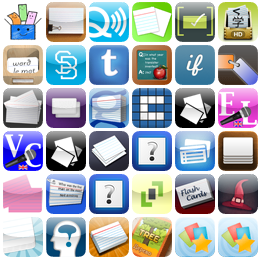
This link was too good to not post: Flashcard apps. I really dig the graphical feature display (just mouse over the icons).
Personally, though, so many choices almost makes me want to ignore all these options altogether. So far, Anki and Pleco are a good combination. I do wonder if these 100+ apps offer anything special, though.
Link via @ajatt.
10
May 2011QQ Live is Awesome
I’ve not been a fan of QQ the IM client, ever since its malware phase c. 2002. I used it to practice typing Chinese with friends online, but it forced me to use “Tencent Explorer” as my default browser as long as the software was installed. I have never forgiven Tencent for that.
Still, this QQ Live application is pretty awesome. I discovered it through its iPad version (and wrote about it in my recent iPad Apps for Chinese Study post), but have heard that there’s a desktop version for Windows that works great too. Get it!
It’s my experience that while this app doesn’t do anything that other apps don’t do, it’s especially fast (even if you’re outside China, I hear) and easy to use. Also, its limited selection is a blessing in disguise. It offers a lot of the popular TV shows and movies (including my favorite, 非诚勿扰), and saves you the trouble of having to search on Baidu video or bittorrent sites.
Remember: this is a free app with no login required. I suspect this is all a promotional trick and that we’ll all have to log in with a QQ ID just to use the program eventually, but that doesn’t mean we can’t enjoy it while it lasts!
05
May 2011iPad Apps for Chinese Study (2011)
We recently purchased an iPad 2 for AllSet Learning, and quickly set about looking for useful apps for learning Chinese. It didn’t take long for me to realize a basic truth about having an iPad: once you have an iPad, you want to run iPad apps on it, not iPhone apps. And the there are way more iPhone apps out there for learning Chinese than there are iPad apps. The purpose of this post is to call attention to the decent iPad apps out there.
I realize this post isn’t going to stay current for very long, and that’s OK. Rapid innovation is one of the things that drew me to the iOS platform in the first place. For now, though, I have my top picks for iPad apps for learning Chinese. One thing I should make clear in advance, though: many of these apps are not explicitly for learning Chinese; they’re simply apps in Chinese (good sources of more input).
Pleco
Yes, I think I’ve mentioned before that I love Pleco. It’s a great dictionary app. It also supports the iPad, while many other iPhone dictionaries don’t. I won’t say too much about Pleco here.
QQ Live HD
I must admit that I’m not a fan of the QQ IM client. But this app is great. It doesn’t require any kind of QQ login or account; it’s just a simple app for streaming Chinese movies and TV shows, and it’s fast (in Shanghai, anyway). I’ve already watched several movies on it, and while I won’t recommend any of those movies, the app does its job just fine.
Zaker
This one is an obvious Flipboard clone, but it’s a really good Flipboard clone. It’s one of those really good clones that tries to one-up the original. And, of course, it’s got tons of Chinese content ready to be added for magazine-style consumption, whether it’s Chinese news, Chinese blogs, or Weibo. It supports copy-paste, too, so you can pop over to the Pleco Pasteboard Reader when you need to.
Chinagram
I’ve reviewed this one before already: Chinagram for iPad.
Radio Chinese Plus+
This app is quite simple. It only offers three Mandarin stations and three Cantonese stations (6 total), but it works just fine.
雷人图片2011
This is just a big collection of silly photos from the internet. Some are funny; many are just bizarre.
一日一囧四格漫画
A collection of poorly drawn comics of the 冷笑话 (dumb joke) tradition. This app, like the last one, demonstrates how simple an iPad app can be.
My Chinese Library, Pinyin Trainer, and Chinese Number Trainer
I’m grouping all these apps together because they’re all by one company, called TrainChinese. While these apps aren’t revolutionary, they’re of good quality and exist in iPad versions. Sadly, not many apps for learning Chinese have met that simple requirement. They all seem to have free versions which are somewhat limited, trying to get you to pay. I recommend the pinyin trainer and number trainer to beginners.
My list of really noteworthy iPad apps for learners of Chinese ends there. There are a few others worth pointing out, though… The four others pictured but not covered are: 枫林书院精选 (an ebook reader that comes with a number of titles), 中国新闻周刊 (China Newsweek), iLearn Chinese Characters Lite, and Kids Mandarin.
These are the apps in the “Good…not HD” folder (I wish they had iPad versions):
These are the apps in the “词典” folder (iPad apps include: iCED, KTdict, eFlashChinese):
These are the apps in the “阅读” folder (iPad apps include: 格林童话集, 中文杂志, 宋词三十首, 三毛全集, 给力书城, 拇指索引圣经, 爱阅读, 让笑话飞, 小姐日记):
These are the apps in the “新闻” folder (none are iPad apps):
These are the apps in the “故事” folder (iPad apps include: Chinese Stories (really bad), Heroes of Three Kingdoms, The Greatest Daddy (English and Chinese), 一千零一夜选, nciku Peter Rabbit):
These are the apps in the “其它” folder (none are iPad apps):
I know I haven’t been exhaustive in my search for good iPad apps; I’d love to hear recommendations!
03
May 2011Chalk “Calligraphy”
I’ve seen Chinese calligraphy written in water many, many times, but this past weekend was the first time I saw it in chalk. (Maybe I just need to go to Chinese parks more?)
25
Apr 2011Readings in Ancient Chinese Poetry
Recently a comment on Sinosplice brought to my attention the fact there are many different videos of poems read in ancient Chinese (古代汉语) [more information on Wikipedia’s classical Chinese entry].
In case you’re not familiar with the concept, every language is slowly changing over time. So not only would the vocabulary and grammar of a language be different if you were able to go back in time and observe, but so would the actual pronunciation. The farther back you go, the bigger the change. As you can imagine, it’s difficult work piecing together the ancient pronunciation of a language when there are no audio records.
I can’t vouch for the accuracy of these videos (I don’t know much about ancient Chinese poetry), but they’re certainly interesting. Try showing them to a Chinese friend and see what kind of response you get. (It’s my impression that while the Chinese are well schooled in ancient poetry, they are often pretty clueless how different the ancient pronunciation of that poetry actually was. It’s not just a tone here or there!)
《關雎》上古漢語朗讀
李白 靜夜思 中古漢語朗讀
The second one is by a Chinese guy who goes by the name of biopolyhedron. He’s got a bunch of videos on both YouTube and on Youku. If you’re interested in this stuff, definitely check out his videos!
19
Apr 2011Chinagram for iPad
I recently had the opportunity to try out Chinagram, a new iPad app which introduces Chinese characters. There aren’t many Chinese-learning apps out there specifically for the iPad, so I decided to review this one.
My first impression of the app is that it is beautifully made. I guess that’s Italian design for you. The overall aesthetic is nice, and there are lots of little touches that make the app fun to use. Don’t miss the “History of Chinese Writing” section. While the information it contains is not something you can’t find on Wikipedia and many other sites, it’s definitely presented here in a way that’s enjoyable to browse. I especially liked the foreground/background faux-3D effect you get when you swipe to a new page.
After my playing with the app a little bit, the key question in my mind was, who is this app for? Is it for an advanced student? An intermediate student? A beginner? Or maybe just a casual student of Chinese? My conclusion, unsurprisingly, is that it’s for the casual student of Chinese. Sure, a beginner can get some use out of it, but since the app only covers 120+ characters, the serious student won’t be using this one for long. The strength of the app, perhaps, is its treatment of the evolution of the characters it contains. The graphics it contains go further than Wenlin, but certainly not ChineseEtymology.org (which is free). And Wenlin costs a lot more, while ChineseEtymology.org actually has an iPhone app now.
There aren’t yet many Chinese learning apps created for the iPad. Chinagram has got to be the most attractive one currently in the app store, and while it’s still $1.99 it’s a good deal for the beginner or casual learner.
14
Apr 2011The Intel Tune in Chinese
You know the little 5-note musical tune that Intel uses everywhere their logo shows up? Yeah, you know the one. It’s very easy to remember. I just became aware recently that this little musical tune has a translation into Chinese. Here it is:
So the Chinese is:
> 灯!等灯等灯!
The English translation of this would be:
> The light! Wait for the light, wait for the light!
This is amazingly appropriate, considering the “English version” of the “lyrics” would be something like:
> Dunnn…. Dun-dun dun-dun!
Not quite as articulate, I gotta say.
The whole idea of “translating a a musical tune into a spoken language” is bizaere, though.
12
Apr 2011Engrish Bookbag
I’m used to seeing Engrish on t-shirts and on signs, but this is the first time I’ve seen Engrish on a bookbag, apparently designed to be read by the people behind the wearer.
How about a closeup of that Engrish?
I have to admit, following this guy, I did enjoy the time in spring, and I appreciated to read it. I elected to skip the bathing, but this bag did bring a smile to my face.
07
Apr 2011Olay PK Ad
I think this is going to be one of Shanghai’s shortest springs ever; we’re practically going straight from winter to summer. And advertisers know it; I saw this ad for skin whitening cream on the Metro the other day:
What struck me about this ad was not the amount of English, but rather the diversity of its usage in the ad:
1. Olay: a famous brand name, untranslated. (This is kind of a ballsy move in China, but some companies do it.)
2. White Radiance: the product’s English name. This is probably mostly for aesthetic effect and symmetry of design.
3. 小S: a name. Yes, her Chinese name is 小S. It might not be her real name, but it’s her name.
4. VS: a term used pretty often in Chinese, appreciated for its simplicity and compact nature. (In Chinese, you spell it out: V-S.)
5. PK: a Chinese verb (derived from “player kill”) popular among the young internet-savvy folk, referring to some type of elimination competition.
The less interesting part is the actual content of the ad. It’s trying to get people to go to a website and vote for the star they think is whiter. Ugh.

